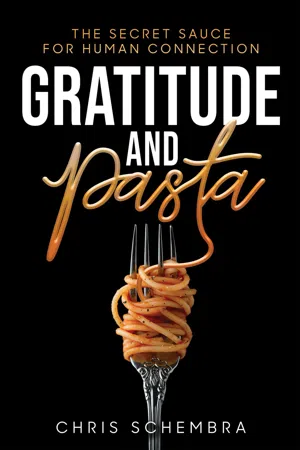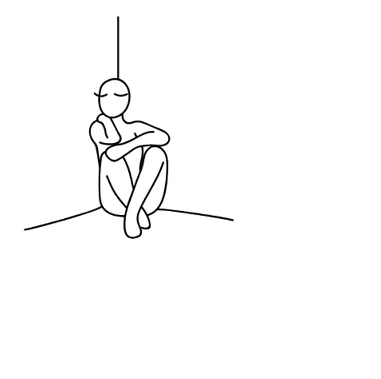
eBook - ePub
Gratitude and Pasta
The Secret Sauce for Human Connection
Chris Schembra
This is a test
- English
- ePUB (disponibile sull'app)
- Disponibile su iOS e Android
eBook - ePub
Gratitude and Pasta
The Secret Sauce for Human Connection
Chris Schembra
Dettagli del libro
Anteprima del libro
Indice dei contenuti
Citazioni
Informazioni sul libro
The epidemic of loneliness and depression among CEOs, executives, and founders is rampant, and yet, we continue to create and foster relationships in the same way we always have – with boring networking events that leave us more disconnected than ever. Born of author Chris Schembra’s own disillusionment with success and his increasing sense of isolation, this book shares the journey of 7: 47 Club dinners and how he used them to foster gratitude, empathy, and human connection in his life and in the lives of thousands of friends and colleagues. This book will teach you to create and structure your own intimate dining events so that your guests will have an experience that will bring them closer together, and closer to you.
Domande frequenti
Come faccio ad annullare l'abbonamento?
È semplicissimo: basta accedere alla sezione Account nelle Impostazioni e cliccare su "Annulla abbonamento". Dopo la cancellazione, l'abbonamento rimarrà attivo per il periodo rimanente già pagato. Per maggiori informazioni, clicca qui
È possibile scaricare libri? Se sì, come?
Al momento è possibile scaricare tramite l'app tutti i nostri libri ePub mobile-friendly. Anche la maggior parte dei nostri PDF è scaricabile e stiamo lavorando per rendere disponibile quanto prima il download di tutti gli altri file. Per maggiori informazioni, clicca qui
Che differenza c'è tra i piani?
Entrambi i piani ti danno accesso illimitato alla libreria e a tutte le funzionalità di Perlego. Le uniche differenze sono il prezzo e il periodo di abbonamento: con il piano annuale risparmierai circa il 30% rispetto a 12 rate con quello mensile.
Cos'è Perlego?
Perlego è un servizio di abbonamento a testi accademici, che ti permette di accedere a un'intera libreria online a un prezzo inferiore rispetto a quello che pagheresti per acquistare un singolo libro al mese. Con oltre 1 milione di testi suddivisi in più di 1.000 categorie, troverai sicuramente ciò che fa per te! Per maggiori informazioni, clicca qui.
Perlego supporta la sintesi vocale?
Cerca l'icona Sintesi vocale nel prossimo libro che leggerai per verificare se è possibile riprodurre l'audio. Questo strumento permette di leggere il testo a voce alta, evidenziandolo man mano che la lettura procede. Puoi aumentare o diminuire la velocità della sintesi vocale, oppure sospendere la riproduzione. Per maggiori informazioni, clicca qui.
Gratitude and Pasta è disponibile online in formato PDF/ePub?
Sì, puoi accedere a Gratitude and Pasta di Chris Schembra in formato PDF e/o ePub, così come ad altri libri molto apprezzati nelle sezioni relative a Business e Business Development. Scopri oltre 1 milione di libri disponibili nel nostro catalogo.
Informazioni
1. You Don’t Have to Be Alone to Be Lonely





If you’ve felt lonely in the last two years, odds are most of your peers have felt as well. We live in a world that is so disconnected and unfulfilled that 51% of the American workforce reports being lonely on a consistent basis. In terms of lifespan, loneliness is equivalent to smoking fifteen cigarettes per day – which takes seven years off your life.1 Loneliness is now more dangerous than stress and obesity, and mind you, being lonely is not the same as being alone.
It’s even worse for entrepreneurs or anybody in a leadership position. It takes an inordinate amount of passion and drive to get a company off the ground, to convince investors that your idea is the next big thing, to keep going when all of the odds are against you. That passion and drive can be a double-edged sword, though, leaving the person bearing it completely burnt-out and disconnected from the reason they started their venture in the first place. It should be no surprise that entrepreneurs, founders, and leaders are twice as likely to suffer from depression, almost twice as likely to struggle with addiction, and are six times more likely to have ADHD.2 When we see high-profile entrepreneurs and thought leaders take their lives (think Kate Spade and Anthony Bourdain), it’s easy to feel as though there is no way to create a more fulfilling life for yourself.
It’s not for lack of trying – we spend our evenings and weekends trying to connect with like-minded people. Maybe we go to a networking event on Tuesday, a mastermind on Thursday, and a conference on Saturday, and yet, the feeling of disconnect doesn’t seem to ease. Today, the number of networking events available to us has exploded, but the feeling of disconnect has only grown.
Unfortunately, the typical networking events have been done to death. Odds are high that you’ve been to a number of dinners or gatherings put on by a wide variety of people – vendors, friends, clients, customers – and yet they all look almost identical to one another. This lack of originality leads to boredom, despair, rage, and general awkwardness.
You’ve probably spent too many nights in another conference room at a hotel with ornate and tacky carpeting, fluorescent lighting, and a lack of natural light, being served the same chicken, steak, or fish that you’ve been offered dozens of times before. If it’s not a conference room, it’s the back room of a restaurant. Hosts these days take the easy route and reserve a table with the intention of hosting an intimate dinner, but it’s impossible to do because a) there are too many people talking; and, b) the restaurant wants to get you in and out so they can capitalize on the next client engagement. According to the number one client engagement events website, Kapow.com, out of thousands of experiences they produced in 2018 and 2019, fifty-two percent were hands-on, private, and food-related events.3
Unfortunately, it’s so easy to fall back on the standard way of doing things with everyone continuing to host bland dinners without considering if there’s a better way to connect. Unsurprisingly, people are craving something different. This way of “treating clients to dinner” needs to be shaken up. Dinners aren’t passé, it’s just that we need to reconsider how we use them.
In his wonderful book, Originals, Adam Grant wrote that it’s not by maintaining the status quo that we get ahead, but by finding and utilizing novel ideas that propel ourselves forward. You don’t have to throw out dinner as a tool for connection with the shareholders in your lives, but by rethinking how it’s done, you can create a far more impactful and meaningful experience for everyone involved – including yourself. In this book, we’re going to present a unique approach to producing dinners. Not the kinds of dinners that leave you rushing for the shower (physically and emotionally), but the ones that leave you bragging about the experience for years to come. You’re going to learn how to create the unique, intentional, engaging, out-of-this-world experiences we’ve used to spark over 400,000 relationships in the last five years.
But before we get to that, let’s talk about you for a moment.
If you’ve picked up this book, the odds are that you’ve noticed this epidemic of loneliness and lack of connection. You might already be intrigued by the idea of using gratitude and emotion as a connection tool for yourself and the people around you. You are probably a cross-section of the people who work for you and work alongside you, and as a result, you’ve built a wonderful company or are on your way there. You’re achieving great things, and everybody’s telling you so, but you somehow feel completely unfulfilled – and maybe even broken inside.
You and I are probably a lot alike. You like to be in control. You like things done a certain way. You like when people follow your suggestions, but it’s also exhausting being in charge all the time. Maybe it feels better to be the smartest person in the room on a regular basis, but every once in a while you like walking into the room and saying, “Damn, I don’t know a thing about what they’re talking about, and that means I’m going to learn something.” Maybe you even secretly miss the safety and the comfort of working for a big company where your manager gives you directions and tells you what’s expected, but that’s not how it is. You’re so busy running your company; it’s hard for you to shut off your brain and relinquish control. If you’re not going to make decisions, who is?
You’re probably someone who chases happiness on a daily basis. You and I both know that happiness is episodic and fleeting, like moments in time. You think you’re doing the right thing, but it doesn’t always feel that way. You’ve gained the accolades and appreciation of your peers, but it feels skin deep because you don’t feel that way about yourself.
And it’s more than just your personal life that feels unfulfilled; in your professional life, you feel like you’re on a rocket ship, and you’re barely able to hold on. You’re so busy raising funds, gaining market share, keeping clients satisfied, and building a team that you feel like it’s a constant race to the top. You feel like if you just got that one new client, or hit your next revenue goal, your company will be set, and yet, you already know that once you hit that goal, there will be another one right after it. Everyone expects hockey stick growth from you, exponential improvement, and here you are just trying to be taken seriously as a thought leader in your field.
The good news is that you’re not alone; that’s how the majority of American entrepreneurs feel. If you can learn to tap into that collective feeling of dissatisfaction and lack of fulfillment, then you’ve stumbled upon a gold mine of opportunity for connection, and every community needs a leader. Let’s make it you!
2. Setting the Table for Gratitude





When I came across Anthony Tumbiolo on Shapr, a networking app, he seemed to be a super successful, good looking guy – the kind of entrepreneur who looked like he had everything figured out. When his profile came across my screen, I swiped right.
Our friendship developed slowly, he attended a few of my pasta dinners, and we went on a few double dates with our girlfriends. All the while, my initial impression of him remained the same: great guy, phenomenal haircut.
A few months went by and I didn’t hear from Anthony, so, being the pushy Italian that I am, I called him and told him I was going to come by his office. We met on a fortuitous Friday, and Anthony looked tired – maybe even a little distraught. There were bags under his eyes for the first time.
I asked him how he was doing. Not so well. He was coming to the realization that his business had taken over his life. He had no time for any of the things that brought him joy, like soccer, or spending time with friends. He was spending too much time working on his company, and he was feeling burnt out, unfulfilled, and unable to sustain this pace anymore. Worse than that, his sleep was troubled because of the stress, which only compounded all of his issues.
By that point, Anthony was already at the helm ...